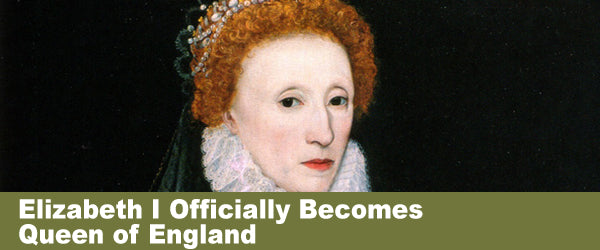
Posted by The Home School in the Woods Team on
You may have seen one of their extravagant weddings aired on television. If not, you’re bound to find their faces on a tabloid at the grocery store! The Royal Family of England is an obsession to many – even for Americans.
Today, Queen Elizabeth II has been ruling England peacefully for the last sixty-seven years (she’s currently the world’s longest-reigning monarch!). However, many fail to realize that Queen Elizabeth II had a storybook queen to role-model her life after.
On November 17, 1558, Queen Elizabeth I became the official ruler of England after many years of unstable leadership. Want to learn more about Queen Elizabeth I’s life and how she came to be known as “Good Queen Bess,” the faithful leader who saved her country from turmoil? Keep on reading!
How Did Elizabeth Become Queen of England?
Elizabeth was an illegitimate child born to King Henry VIII and his second wife, Anne Boleyn, in 1533. However, her mother would sadly be executed by her father when Elizabeth was just two years old.
Elizabeth grew up during the Renaissance and Reformation, a period during the 16th century that sought to reform misguided doctrines within the Roman Catholic Church. This movement was led by famous Christians such as Martin Luther and ended with the establishment of Protestant churches. The Roman Catholic Church countered this Reformation by cleansing their own issues – this was called the Counter-Reformation.
However, it was a long road to get to that point, as England would see both the government and the Church swing from Protestant, to Catholic, to everything in between.
King Edward VI
When King Henry VIII died, all three of his children – Edward, Mary, and Elizabeth – would have a chance at the throne. Although it was unlikely Elizabeth would get the opportunity since she was third in line and an illegitimate child.
Edward VI was the first to inherit the crown around the age of 10. Unlike his father, who had been Protestant in name but Catholic in beliefs, Edward, along with his advisors, were thoroughly Protestant. Edward reigned for six years until he died from a lung condition on July 6, 1553.
Queen Mary I
The next in line for the throne was Edward’s half-sister, Mary I. However, many disliked the idea of her becoming queen since she was Catholic, and most of those in leadership were Protestant. This led them to elect Jane Grey, a distantly connected member of the royal family.
After nine days of leadership, the people of England decided that keeping Mary from becoming queen was wrong. So, Jane Grey, who never wanted to be a queen from the start, stepped down, and Mary Tudor became queen.
Mary, much like her stepbrother, Edward, was very frail. However, she survived her youth and was now in her mid-thirties. As queen, Mary had an agenda to make Catholicism England’s primary religion. This eventually led to her strict laws against Protestants and even burning them at the stake as heretics – coining her nickname “Bloody Mary.”
After five years of ruling England, Mary became sick and died, leaving behind no children. This meant that the crown belonged to Henry’s only surviving out-of-wedlock child – Elizabeth.
Queen Elizabeth I
Elizabeth was an unexpected heir to the throne, but she went above and beyond what people expected. Now twenty-five years old, Elizabeth was healthy, strong, and ready to lead the country. Elizabeth I’s coronation took place at Westminster Abbey, London, on January 15, 1559.
During her reign, England flourished not only in terms of peace and stability but also in fashion, art, literature, and more. Many great philosophers and writers like William Shakespeare lived during this time. The people would remember it as the “Elizabethan era,” a romantic time of nobility and entertainment.
Elizabeth’s leadership was favored by the people of England. Not only was she elegant and attractive, but she was intelligent and clearly capable of leading her country when faced with difficulties. On top of this, Elizabeth managed to keep wise counsel, who helped her make several good decisions.
When it came to the problem of Catholicism versus Protestantism, Elizabeth handled it fairly and with tact. Although she considered herself Protestant, she held close to Catholic practices and behavior. Unlike Elizabeth I’s siblings, she did not wish to force her beliefs on her people.
She attempted to heal the relationship between the two beliefs by blurring the lines of what exactly you had to believe to attend the official Anglican Church of England. This vagueness made it possible for both Catholics and Protestants alike to attend church services together. However, there was no doubt that England, as a whole, had become a Protestant country.
Despite her witty, flirtatious attitude, Elizabeth never married and claimed to be a virgin until the day she died. Some even called her the “Virgin Queen.” By the end of Elizabeth’s reign, she managed to recover the country from years of detrimental instability.
With no children or spouse, Elizabeth passed the crown off to her distant relative, James VI of Scotland, who was also Protestant. This gave Elizabeth peace of mind knowing that her country wouldn’t come to see religious instability any time soon again.
From there forward, the people of England would look back on Elizabeth’s long reign of 44 years as prosperous and a memory they wished they could relive again.
More on Queen Elizabeth I of England
As you can see, the Royal Family is filled with interesting history – Elizabeth I just being a piece of it!
If you’re looking to add Queen Elizabeth to your child’s history curriculum, check out one of our many Project Passports, the Renaissance and Reformation, where you can learn more about several kings, queens, and what life was like during the Renaissance – from music, art, literature, drama, politics, and more!

I love history, thank you for this article.